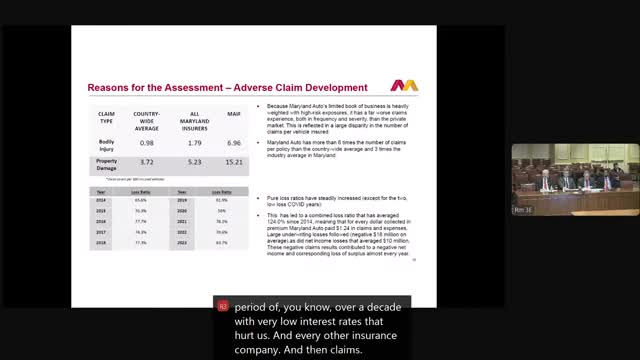Maryland insurance rates set for 13% increase amid rising claims and affordability challenges
January 23, 2025 | Finance Committee, SENATE, SENATE, Committees, Legislative, Maryland
This article was created by AI summarizing key points discussed. AI makes mistakes, so for full details and context, please refer to the video of the full meeting. Please report any errors so we can fix them. Report an error »

During a recent meeting of the Maryland General Assembly's Finance Committee, discussions highlighted the rising costs of auto insurance and the challenges faced by policyholders in the state. A key focus was the impact of increased driving speeds and post-pandemic supply chain issues, which have led to higher repair costs and longer wait times for vehicle repairs.
Insurance representatives noted that these factors have contributed to a significant rise in claims, particularly for their policyholders, who tend to file more claims than those with other carriers. Additionally, the prevalence of fraud has further complicated the financial landscape for insurers.
A major point of discussion was the affordability index, which mandates that insurance rates in low-income communities be set 20% to 40% lower than they would otherwise be. While this initiative aims to make insurance more accessible, it has also resulted in financial losses for insurers, leading to a decline in surplus funds.
The conversation also touched on the issue of uninsured motorists. Maryland's approach to affordability has allowed many drivers who might otherwise be uninsured to obtain coverage, which in turn lowers the cost of uninsured motorist coverage for all drivers in the state. Comparatively, drivers in Washington, D.C., face higher rates due to a lack of similar affordability measures.
In response to these challenges, insurance companies have implemented several rate increases, including a recent 13% hike that is set to take effect soon. Further increases are anticipated later in the year as insurers strive to ensure that their rates are adequate while still adhering to affordability guidelines.
As the committee continues to address these pressing issues, the outcomes of these discussions will have significant implications for Maryland drivers, particularly in terms of insurance affordability and coverage options. The ongoing adjustments in rates and policies reflect a broader effort to balance financial sustainability for insurers with the need for accessible insurance for all residents.
Insurance representatives noted that these factors have contributed to a significant rise in claims, particularly for their policyholders, who tend to file more claims than those with other carriers. Additionally, the prevalence of fraud has further complicated the financial landscape for insurers.
A major point of discussion was the affordability index, which mandates that insurance rates in low-income communities be set 20% to 40% lower than they would otherwise be. While this initiative aims to make insurance more accessible, it has also resulted in financial losses for insurers, leading to a decline in surplus funds.
The conversation also touched on the issue of uninsured motorists. Maryland's approach to affordability has allowed many drivers who might otherwise be uninsured to obtain coverage, which in turn lowers the cost of uninsured motorist coverage for all drivers in the state. Comparatively, drivers in Washington, D.C., face higher rates due to a lack of similar affordability measures.
In response to these challenges, insurance companies have implemented several rate increases, including a recent 13% hike that is set to take effect soon. Further increases are anticipated later in the year as insurers strive to ensure that their rates are adequate while still adhering to affordability guidelines.
As the committee continues to address these pressing issues, the outcomes of these discussions will have significant implications for Maryland drivers, particularly in terms of insurance affordability and coverage options. The ongoing adjustments in rates and policies reflect a broader effort to balance financial sustainability for insurers with the need for accessible insurance for all residents.
View full meeting
This article is based on a recent meeting—watch the full video and explore the complete transcript for deeper insights into the discussion.
View full meeting
